PRACTICING COMBAT TECHNIQUES IN STRIKING HANDS
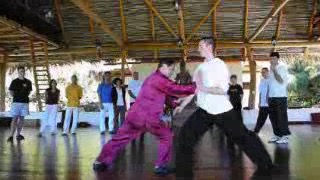
While “Tui Shou” or Pushing Hands develops combat skills, “Da Shou” or Striking Hands trains techniques for combat. A common misconception among many Taijiquan practitioners is that if they are proficient in Pushing Hands they would be effective in combat. This is not necessarily so because they still have not learnt the techniques for combat though they may have the skills.
On the other hand, those who know combat techniques but lack the skills to apply them well, are also inadequate in combat. These problems arise because the practitioners fail to realize the difference between techniques and skills.
“Da Shou” literally means “Striking Hands”, or striking techniques. But Chinese is a concise language, and “da” here refers not just to striking but to all the four categories of attack, namely striking, kicking, felling and “chin-na” or gripping. Hence, in this section of Taijiquan training, all the different kinds of attack and their defence are dealt with.
Top and Middle Strikes and Defences

You and your opponent strike to the top and middle levels, and their defences. Note the use of body-movement in deflecting the attacks and countering.
Different Hand Forms and Levels in Countering

You deflect your opponent's attack and counter-attack at the top, middle and bottom levels. Note the different hand forms, namely, finger thrust to the top, palm strike to the middle, and vertical punch to the bottom levels.
Low Cloud Hands
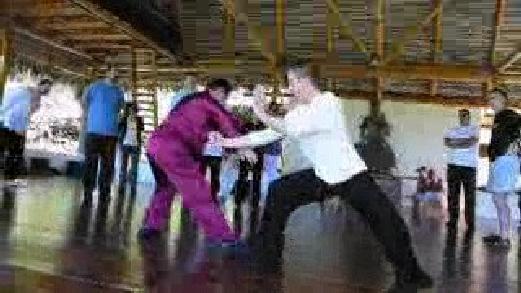
If the punch is low, use low cloud hands to ward it off. Cloud Hands can be used against middle or top attacks.
Yellow Bee Sucks Pollen
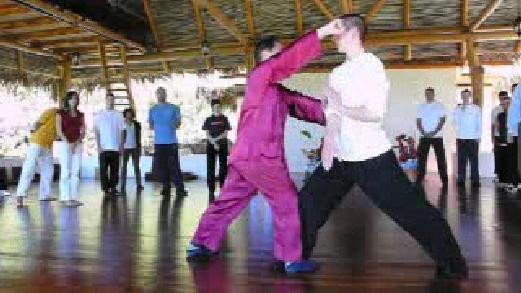
This is a close-range side attack. It is important to cover the opponent before attacking him. If he risks injury and counter-attacks recklessly, you should abandon the initial attack to protect yourself first.
Punch Below Sleeves

If an opponent swings a powerful side-attack at your temple, move back to avoid his full momentum and sweep away the attack according to its momentum. Then covering his hand, strike him at his ribs.
Various Counters against the Same Attack
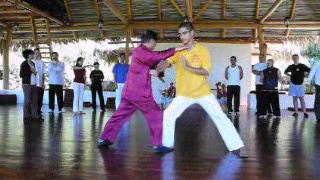
Of course, there are different counters against the same attack. Besides using a low vertical punch against the swinging side attack, you can also counter with a finger thrust to an opponent's throat or a palm strike to his chest.
Responding Spontaneously
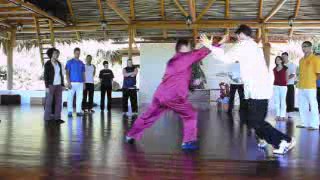
You must respond not just correctly to an attack, but spontaneously. You need not, and should not, think about what response to make. The correct response should come naturally and spontaneously. This comes about from systematic training.
Intuitive, not Intellectual, Response
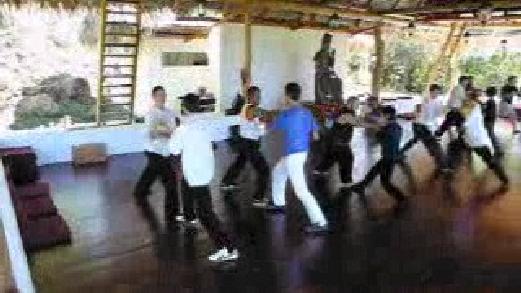
Participants practice responding spontaneously to their partners' attacks, which are not pre-arranged. The responses are intuitive, not intellectual. In other words, you don't observe the attack, decide what response to make, then make it.
Practicing Combat Techniques in Striking Hands from Wong Kiew Kit on Vimeo.
LINKS
Wahnam Taijiquan Training from Basics to Free Sparring
- Part 1 — The Secret of the Internal Force Masters
- Part 2 — Cloud Hands: From Chi Flow Movements to Patterns and Sets
- Part 3 — Developing Combat Skills in Pushing Hands
- Part 4 — Practicing Combat Techniques in Striking Hands
- Part 5 — Applying Kicks, Throws and Grips in Striking Hands
- Part 6 — Combat Sequences 1 and 2: Top, Middle, Bottom and Sides
- Part 7 — Combat Sequence 3: Pressing Attacks and How to Defend against Them
- Part 8 — Combat Sequences 4 and 5: Thrust Kick, Side Kick and Whirlwind Kick
- Part 9 — Combat Sequence 6: Felling Opponents with Carrying Tiger Back to Mountain
- Part 10 — Combat Seqeences 7 and 8: Chin-Na or Gripping Attacks and their Defences
- Part 11 — The Eight Simplified Combat Sequences of Wahnam Taijiquan
- Part 12 — From Guided Sparring to Free Sparring in Wahnam Taijiquan
Courses and Classes
